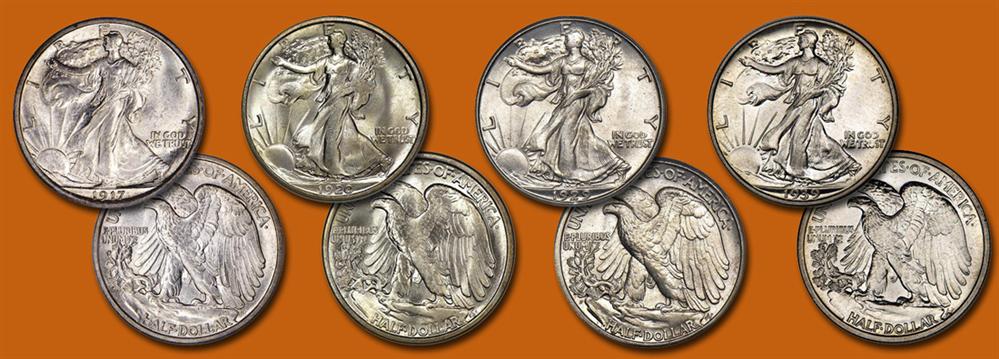
The half dollars were first struck in 1916 and at all three mints — Philadelphia, Denver, and San Francisco. The D and S mintmarks on the branch coins appeared at the lower right of the obverse. This position was continued into early 1917, after which the mintmarks were removed to a less conspicuous position at the left of the reverse.
Production of the half dollars continued apace at all three mints, until the recession of 1921 took effect. In that year three different varieties were produced, but that was the end, temporarily, and none were struck in 1922. Then began an intermittent issuance with 1923-S, then a jump to 1927, a skip then to 1929, and then the next coinage at the San Francisco Mint in 1933. The last initiated continuous production through the end of the design in 1947.
Some years ago Whitman produced albums that included half dollars from 1916 to 1940 in the first album and 1941 to 1947 in the second. Today the collecting of a “short set,” 1941 to 1947, of all dates and mints, is a very popular pursuit. None are rarities and most can be found with somewhat decent striking.
Regarding sharpness of strike, this varied widely over the years. The design was such that the position of Miss Liberty’s hand at the center of the obverse was deep in the die, and required an extra effort for the metal to fill it completely. The result is that nearly all Walking Liberty half dollars are weak in this area, with certain of the hand details not visible. Exceptions are the years in which Proofs were made, 1936 to 1942. Most of the dates and mintmarks 1916 to 1947 are more or less tolerable regarding strike, even if not sharp at the center and on the details of the head. The worst offender, so to speak, is the 1923-S, of which I have never seen a decently struck piece. If such were to be found it would certainly be a prize, although it could be that no extra premium would need to be paid for it as sharpness of strike is not mentioned on certified holders.
In 1948 the Walking Liberty half dollar was replaced by the Franklin design. A long-time favorite disappeared into history. Franklin halves were not particularly popular when they appeared, and this sentiment continued for a number of years. However, in recent decades they have experienced a great rise in popularity, and today they are actively collected. Franklin half dollars from 1948 to 1963 have the advantage that there are no key issues, no rarities to contend with. It is easy enough to put together a complete set in, say, MS-65 grade. Pieces that are more sharply struck than others (but not necessarily sharp overall) are designated Full Bell Lines or FBL, and command sharp premiums for some issues for which there are few. In 1964 the Kennedy half dollar succeeded the Franklin and is still with us.





